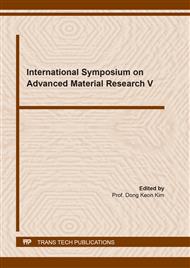p.3
p.9
p.17
p.25
p.35
p.43
p.53
p.63
Synthesis and Properties of One-Component Addition-Crosslinking Silicone Resin
Abstract:
A kind of MDT polysiloxane was prepared by step hydrolysis and polycondensation of alkoxysilane. It could be cured at elevated temperature with existence of microencapsulated platinum catalyst. The effects of crosslinkable groups’ contents and PhSiO1.5 content on properties of cured silicone resin were studied in detail. When the contents of crosslinkable groups were 20mol% to 30mol% and the PhSiO1.5 content was 25mol% to 30mol%, the cured silicone resin had good tensile strength, flexural strength, moderate elasticity, and low viscosity. With the increase of PhSiO1.5 content from 17mol% to 32mol%, Tg of the silicone resin could be improved by 50°C to 128°C. The thermal stability was explored by thermo gravimetric analysis. The onset temperature of thermal degradation and the center temperature of thermal degradation were 486°C and 548°C, respectively. The average dielectric constant was about 2.45 and the dielectric loss tangent value was less than 0.01. The silicone resin also showed a high-volume resistivity of 5.6×1016Ω•cm. These results suggest that such silicone resin is suitable for utilization in electronic packaging.
Info:
Periodical:
Pages:
9-15
Citation:
Online since:
March 2022
Authors:
Price:
Сopyright:
© 2022 Trans Tech Publications Ltd. All Rights Reserved
Share:
Citation:


